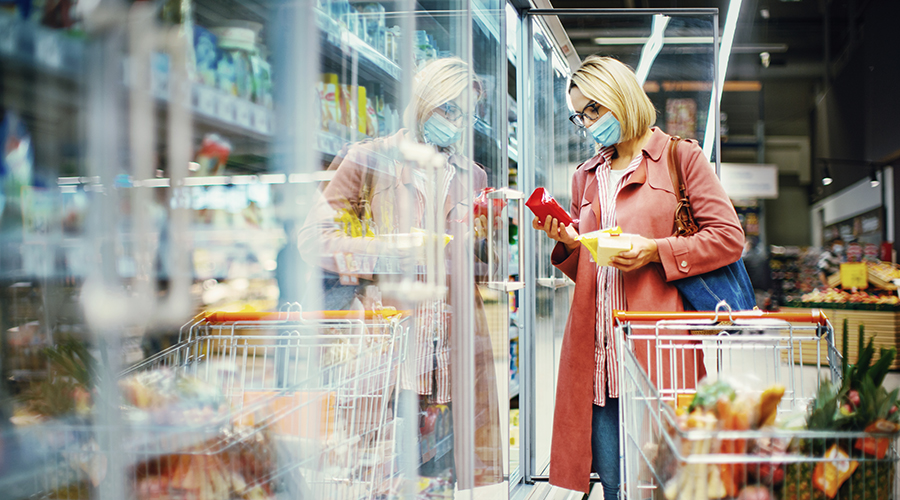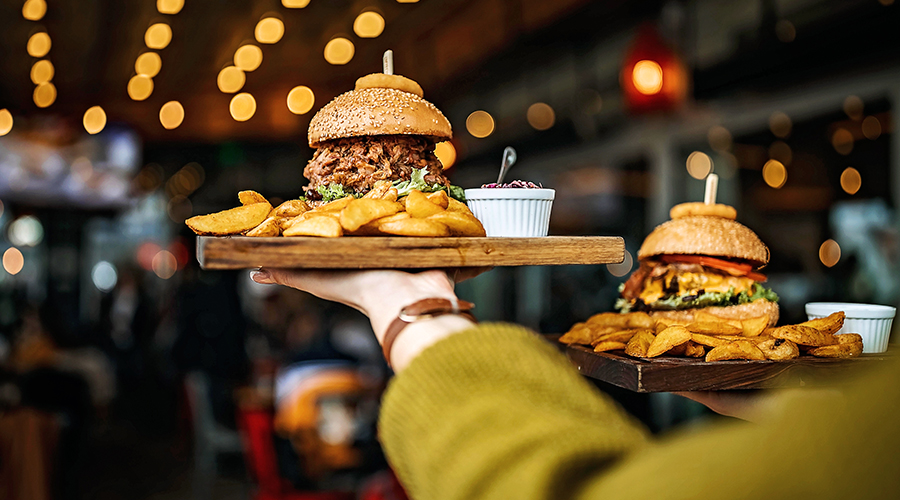Put an asterisk in your record-keeping in 2020 and 2021.
After a stressful 2020, many people have turned to food as a means of comfort, well-being, and community. Food as self-medication, healthier options, organics, plant-based meats, and premium products did very well. Consumers have extra money they could not spend at the restaurant. Forty-two percent of Americans said they had made changes to their eating and drinking habits. This included limiting sugars, “clean eating,” losing weight, and following other diets like keto. Thirty-six percent reported cooking more simple foods, trying new recipes (30%), or new cooking techniques (19%).*
State of the Industry 2021
Beef Beef (Feeding Quality Forum) Chicken Pork Turkey Lamb VealSeafood Food Safety Packaging Sustainability Animal Agriculture Animal Welfare Watch the 2021 State of the Industry Webinar Register for free today!Many people continue working from home, and consumers were forced to learn how to cook. This is something they will not unlearn. During COVID-19, 86% of the meals originated from home. Twenty percent of the population is still working from home, and 43% are working in a hybrid work environment.
Without the luxury of restaurant meals and well-stocked grocery shelves, people browsed their pantries and transform overlooked canned and dry goods into interesting meals. Many familiarized themselves with the ingredients they already had on hand. Perishable foods are up 16% versus 2 years ago, and small appliance sales are up 26% including air fryers (50%), toaster ovens (61%), rice cookers (38%), and electric grills (99%).
This shift will have a long-term effect on the restaurant business, and the home food adventure will expand. Virtual cooking classes, TV cooking classes, and cooking parties will also become more popular once we start getting back together socially.
2021 is an extension of 2020, but we did not have the hoarding event that occurred in 2020. Purchase habits are now returning partially to pre-COVID patterns. Amazon was up 42% in 2020, but it’s down slightly in 2021. Because people had extra spending money, they switched to premium items, and indulgence consumption accelerated.
One hundred million people age 16 and over are not in the labor force. This is up 17% over the past decade. Only 56% of working-age women participate in the labor force, and the lower rate of working women will negatively affect restaurant usage. In addition, the U.S. population is aging. The U.S. Census Bureau reported over 54 million people will be 65 years old or over — about 16.5% of the U.S. population. This age group should reach 22% of the population by 2050. ***

Shopping
Eighty-three percent of consumers changed grocery shopping/e-commerce habits during the COVID‐19 lockdown. Seeking safer methods of shopping for groceries amid the pandemic, adoption of online ordering, pickup, and delivery accelerated. In 2020, 52% of shoppers indicated they bought groceries online; in 2021, that number grew to 64%. Every generation increased in frequency of online grocery shopping, with more than one-fourth (29%) of consumers placing a weekly order. Consumers now are shopping online at 4.3 times the rate they were in 2017, but in-store is still popular, with 95% saying they combine physical and digital grocery shopping. Sixty-one percent of consumers shop for groceries online more now than they did pre-COVID. Reasons include time savings (59%), personal safety (49%), and avoiding impulse purchases (31%). Among respondents, 69.3% “always” made a shopping list, and 20.3% did “sometimes.” A total of 62.7% are only shopping once a week — a significant reduction.
New products that were lucky enough to get launched and gain distribution just prior to COVID-19 are doing well.
Consumer food safety concerns
Ninety-one percent of the grocery shoppers were concerned about food safety, and merchants should highlight their good track record. Findings revealed that 64.2% of the respondents “always” wash or sanitize their hands after grocery shopping, 42.9% cleaned packaged goods “always,” and 39.6% sometimes. What’s more, 27.8% of shoppers reported “always” changing clothes after shopping, and 41.5% sometimes.
New product development
Many of the new product development rollouts were delayed. New products that were lucky enough to get launched and gain distribution just prior to COVID-19 are doing well. Retailers have been just trying to put things on the shelf to satisfy consumer demand. Planograms weren't always correct, but they were just keeping the shelves full. Our industry is always developing new products; it will be interesting to see how the backup gets handled.

Alternative Foods
Concern over mental and physical well-being has affected consumer habits, but this sector still represents a niche. Organics continue to grow, and there is an influx of new consumers joining the vegan and vegetarian lifestyle. There is also an influx of new plant-based items to include in a diet.
Homemade bread became a trend during the pandemic. Sourdough, hardy rye, and home-baked pieces of bread are sticking with us in 2021. Keto-based diets continue to grow as a carb alternative diet, with items like cauliflower-based pizza crust making it easier to stick with a low-carb diet. Gluten-free diets have been supplemented by replacing flour with rice-based flours.
Plant-based foods that directly replace animal products grew 27 percent in 2020 to $7 billion. Plant-based burgers are leading the category and have been joined by plant-based chicken tender substitutes and sausage substitutes. Plant-based chicken jerky has also emerged.
One-third of those polled in the U.S. now consider themselves flexitarian, alternating between vegetarian meals and meals with traditional proteins. Chickpeas are just not just for hummus anymore; their surging popularity will be worth watching.
Feed Ingredients
Feed ingredients, corn, and soybean prices have increased dramatically driven by high demand levels, elimination of inventory carryover absorbed by domestic and global demand, and low yields in 2019. Prices have reached high price levels from 2011. The Chinese also became big buyers, almost reaching the levels they agreed to purchase in 2020 per the Trump trade agreements.
Sustainability
Sustainability is the top consumer and trade priority. Fifty-nine percent of Americans said it’s important that the food products they purchase or consume are produced in an environmentally sustainable way. Their knowledge of and interest in sustainable options like regenerative agriculture, carbon-neutral processes, minimal packaging or locally grown products increased yearly with net familiarity at 36% and net interest at 57%.*
Key pillars of sustainability are: Defining the goals of the organization, commitment to continuously improve the supply chain, measuring results, and investing in improving the sustainability of our planet and its people. It's key to remain cost-effective, foster community support, practice food safety and food security, honor consumers/employees’ well-being, and improve supply chain efficiency. Place a high priority on animal health and well-being, biosecurity, productivity, and efficient grow-out. Preserve the planet through energy use, greenhouse gas reduction, conservation, air quality, and land and water use/quality.
Hospitality Industry
The restaurant industry continues to do a higher percentage of their business out of the drive-thru and via delivery. The restaurant industry, although booming prior to the pandemic, was also overbuilt. According to Fortune magazine, in 2020 more than 110,000 eating and drinking establishments in the United States closed for business—temporarily or permanently.**
Restaurant owners have been very creative, trying new and different strategies and adapting to the new normal. The foodservice industry is resilient— it was 1.1% larger in July 2021 than July 2019, and 31% larger compared to 2020 according to Technomic’s TIndex (an index on total foodservice industry reported monthly).
There is a strong desire to return to normal among consumers. Las Vegas was empty, but once restrictions were removed it was at 100% guest capacity two weeks later. Staffing, however, is very difficult; many of those casino workers found other employment.
Mergers and Acquisitions
It has been a busy year in acquisitions. Consolidation amongst all categories will continue.
Sanderson Farms is being purchased for $4.53 billion in a transaction that will combine Sanderson and Wayne Farms, a subsidiary of Continental Grain Co. Cargill is also a partner in the deal.
Other deals include Hormel Foods’ $3.35 billion acquisition of Planters from Kraft Heinz, Biosev acquisition of Raizen Energia for $670.1 million, Al Ghurair Foods/Al Rajhi Holding Group’s acquisition of Third Milling for $200 million, Opotiki Packing acquiring Coolstorage by Seeka for $59 million, and Barilla Holding’s acquisition of Pasta Evangelists for $48.73 million.
Transportation
Transportation continues to be a major challenge. Products or packaging coming in from overseas are backed up at ports around the U.S., availability of truck drivers is very limited, and labor is very tight. Workers who were laid off during COVID found different employment, and finding skilled labor to replace them is very difficult.
Summary
Spurred by major cost increases from many sources including transportation, ingredients, corrugated, labor, and energy, food manufacturers are doing what they can to recover their increased costs. In the food business, prices go up slowly and fall quickly if demand softens. The Asterisk Years will change consumption patterns forever. We live in a global economy; things will continue to change quickly by circumstances beyond our control. Those companies that are forward-thinking and not just reacting will prosper.
Sources
*https://foodinsight.org/food-trends-to-watch-in-2021/
***NPD group /reports the Bureau of Labor Statistics





Report Abusive Comment